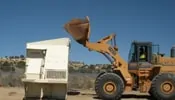


SCS Engineers was retained by the Bureau of Indian Affairs (BIA), Navajo Regional Office, to clean close Trench 2-1, located in the southwest corner of the Gamerco Supply Center Landfill in New Mexico. According to the Statement of Work, the area requiring remedial action was approximately 7,500 cubic feet. The waste was described as metals, wood, bricks, rebar, clay pipe fragments and construction debris. No hazardous constituents had been found during earlier investigation and excavation activities.
Soil and landfill debris were excavated from the remedial area with a track excavator, and the excavated materials were placed via front end loader onto a vibratory screen to separate the soil from the wastes. The excavated soil was stockpiled on site, and clean soil was imported to backfill the excavation.
The excavated wastes consisted of wood, metal, pieces of plastic, and empty printer toner containers. Several dry cell batteries were removed and stored on 20-mil plastic sheeting for future recycling. Larger pieces of metal were segregated and recycled. The remaining debris was transported to a landfill in Colorado.
Following excavation activities, SCS collected soil samples from the base of the excavation and from the stockpiled screened soil. The samples were analyzed for volatile organic compounds (VOCs), polynuclear aromatic hydrocarbons (PAHs), organochlorine pesticides (OCPs), organochlorine herbicides (OCHs), and eight RCRA metals. None of the samples contained detectable levels of VOCs, OCPs, or OCHs, but PAHs and metals were detected. One sample from the stockpiled screened soil exceeded the New Mexico Environment Department (NMED) soil screening level for benzo(a)pyrene.
The excavated soil was transferred to a licensed landfill farm in New Mexico. At the request of the disposal facility prior to the transfer, a toxicity characteristic leachate procedure (TCLP) was conducted on a sample of the screened soil to test for inorganics, volatile organic compounds, semi-volatile organic compounds, organochlorine pesticides, and metals, and it was verified that the soil was not classified as hazardous.